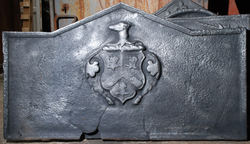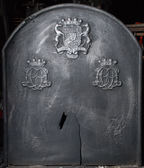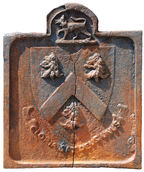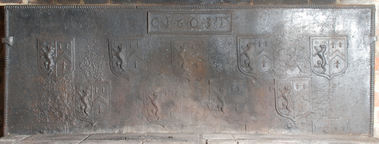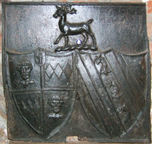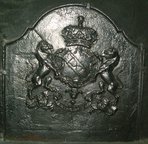-
622
Description: Rectangular with pediment arch; ovolo-moulded edging; central shield, mantling and crest: per pale, on a chevron between three heads erased, as many mullets; crest: a hind’s head erased.
Notes: No secure identification of the arms. The blazon may be: Per pale on a chevron between three ?gryphons’ heads erased, three mullets (the tinctures are not known). The crest appears to be a hind's head erased. Sold at Christie's Masters and Makers auction, 30 November 2010, lot 531 (£688).
Copies of this fireback are known.
Arms: Not known
- Decoration tags:
- rectangular with triangular arch (shape)
- ovolo (edging)
- carved pattern panels
- armorial
Manufactured: in the late-16th to early-17th century possibly in the Weald area of England.
Current location: not known.
- Attached to series:
- Personal armorial firebacks
-
641
Description: Rectangular with arched top; astragal moulded edging (top and sides); top centre, shield, supporters, coronet and motto of the 1st Baron Ashburnham: (1st & 4th) gu. a fess between six mullets ar. (Ashburnham), (2nd) az. semee of fleurs-de-lys a lion rampant guardant ar. (Holland), (3rd) erm. three crescents gu. (Kenn); on an escutcheon of pretence, sa. a chevron between three boys' heads couped at the shoulders proper each entwined around the neck with a snake vert (Vaughan). Supporters: two greyhounds sa. their faces, breasts, and feet ar. collared and lined or; below left and right, a monogram of B and J with a baron’s coronet above.
Notes: John Ashburnham, who married Bridget Vaughan in 1677, was created baron in 1689. he died in 1710. The fireback dates from between 1689 and 1710.
Inscription: LE ROY ET L’ESTAT
Arms: John, 1st Baron Ashburnham
- Decoration tags:
- rounded arched (shape)
- astragal (edging)
- carved stamps
- armorial
- text
Manufactured: in the late-17th to early-18th century probably at Ashburnham Furnace in the Weald area of England.
Current location: Mark Ripley Forge & Fireplaces, Northbridge Street, Robertsbridge, East Sussex, England.
- Attached to series:
- Ashburnham family firebacks
- Personal armorial firebacks
-
643
Description: Rectangular, with canted top corners; twisted rope edging (top and sides only); eight shields of Ayloffe impaling Sulyard in three rows, 3-2-3; Ayloffe: sable, a lion rampant Or, collared gules, between three crosses formy of the second; Sulyard: argent, a chevron gules between three pheons inverted sable.
Notes: William Ayloffe (c1535-1584) of Bretons, Hornchurch, Essex, Justice of the Court of Queen’s Bench, married (c1560) Jane, dau. of Sir Eustace Sulyard, of Runwell, Essex. Christie's Masters and Makers Sale, South Kensington, 30 Nov 2010, lot 518 (£1,000).
Copies of this fireback are known.
Arms: Ayloffe impaling Sulyard (William Ayloffe of Bretons, Hornchurch)
- Decoration tags:
- rectangular with canted top corners (shape)
- rope (edging)
- carved stamps
- armorial
Manufactured: in the early-17th century in the Weald area of England.
Current location: not known.
- Attached to series:
- Ayloffe series
- Personal armorial firebacks
-
821
Description: Arched rectangular shape; fillet edging; shield, crest and motto in relief in a recessed arched rectangle.
Notes: The arms are of Weston, of West Horsley, Surrey: Sable, a chevron or between three leopards heads erased argent crowned or and langued gules; crest: a wolf passant ducally gorged or; motto: Gloria sat Deus unus - God alone is sufficient glory; the Westons were at West Horsley Place from the mid 18th century.
Inscription: GLORIA SAT DEUS UNUS [God alone is sufficient glory]
Arms: Weston family of West Horsley, Surrey
- Decoration tags:
- rectangular with round arch (shape)
- fillet (edging)
- whole carved pattern
- armorial
- text
Manufactured: in the mid- to late-19th century in England.
Current location: Mark Ripley Forge & Fireplaces, Northbridge Street, Robertsbridge, East Sussex, England.
- Attached to series:
- Personal armorial firebacks
-
663
Description: Rectangular, with canted top corners; twisted rope edging (top and sides only); nine shields of Ayloffe impaling Sulyard in two rows, 5-4; two parallel vertical cuts for the insertion of firedogs.
Notes: Ayloffe: sable, a lion rampant Or, collared gules, between three crosses formy of the second; Sulyard: argent, a chevron gules between three pheons inverted sable. William Ayloffe (c1535-1584) of Bretons, Hornchurch, Essex, Justice of the Court of Queen’s Bench, married (c1560) Jane, dau. of Sir Eustace Sulyard, of Runwell, Essex. There is a large number of variants using the same shields.
Arms: Ayloffe impaling Sulyard (William Ayloffe of Bretons, Hornchurch)
- Decoration tags:
- rectangular with canted top corners (shape)
- rope (edging)
- carved stamps
- armorial
Manufactured: in the early-17th century in the Weald area of England.
Current location: in private hands, Rolvenden, Kent, England.
- Attached to series:
- Ayloffe series
- Personal armorial firebacks
- Andiron slot firebacks
-
665
Description: Rectangular; twisted rope edging (probably on on top and sides only); cavetto-moulded-edged rectangle top centre, enclosing date between initials; 14 shields of Ayloffe impaling Sulyard in three rows (5-4-5).
Notes: Ayloffe: sable, a lion rampant Or, collared gules, between three crosses formy of the second; Sulyard: argent, a chevron gules between three pheons inverted sable. William Ayloffe (c1535-1584) of Bretons, Hornchurch, Essex, Justice of the Court of Queen’s Bench, married (c1560) Jane, dau. of Sir Eustace Sulyard, of Runwell, Essex. There is a large number of variants using the same shields. The bottom part of the fireback is obscured in the photograph. The initials 'CT' are likely to be those of Charles Tyler, a founder whose working life and that of his family have strong parallels with the occurrence of these firebacks.
Inscription: C.1.6.0.3.T
Arms: Ayloffe impaling Sulyard (William Ayloffe of Bretons, Hornchurch)
- Decoration tags:
- rectangular (shape)
- rope (edging)
- carved stamps
- individual letters
- individual numbers
- armorial
- text
Manufactured: in 1603 possibly at Bedgebury Furnace, Goudhurst in the Weald area of England.
Current location: in private hands, Rolvenden, Kent, England.
Citation: Gardner, J. S., 1898, 'Iron Casting in the Weald', Archaeologia, 56, 1, pp. 133-164.
- Attached to series:
- Ayloffe series
- Personal armorial firebacks
-
667
Description: Armorial within complex ovolo moulded edging (top and sides); quartered shield, helm, crest and mantling; plain panel below.
Notes: The arms can be identified from the first four quarters on the memorial to Raffe Maynard, d.1613, in St Albans Cathedral; quarterly, 1, Maynard: argent, a chevron azure between three sinister hands couped at the wrist gules; 2, Filleigh: gules, a fess vairy between six crosses formy or; 3, Harris/Hawes/Hewish: gules fretty argent a canton of the second; 4, Lyons: argent a chevron sable between three lions dormant coward gules; the crest, a stag statant, is of Maynard. The Maynards, originally from Devon, were a large family in Rotherfield, and Richard Maynard (d.1619) had an interest in Old Mill, Mayfield, as well as in Birchden forge, and probably Hamsell furnace. An example without the extension panel at the bottom has been noted. A larger fireback with the same arms, and probably by the same pattern maker, can also be seen (no. 144).
Copies of this fireback are known.
Arms: Maynard
- Decoration tags:
- rectangular with round arch (shape)
- ovolo (edging)
- whole carved pattern
- armorial
Manufactured: in the late-16th century in the Weald area of England.
Current location: Hole Park, Rolvenden, Kent, England.
- Attached to series:
- Personal armorial firebacks
- Ornate border series
- Maynard arms firebacks
-
976
 ? x ? mm
? x ? mmDescription: Plain rectangular plate with detached pediment; central shield with motto scroll below.
Notes: The severe classical form suggests that this back may have been intended for attaching to a grate. Blazon: Tynte - Gules, a lion couchant between six cross-crosslets Argent; Kemeys - Vert, on a chevron Argent three pheons Sable.
Inscription: DYW DY RAS
Arms: Tynte quartering Kemeys
- Decoration tags:
- rectangular with detached pediment (shape)
- none (edging)
- whole carved pattern
- armorial
Manufactured: in the 18th century in Wales.
Current location: Cefnmabli, Rudry, Glamorgan, Wales.
- Attached to series:
- Personal armorial firebacks
-
1031
Description: Rectangular; astragal and fillet edging; two heater-shaped shields side by side, with a stag trippant crest above centre.
Notes: The dexter shield: quarterly first and fourth - Mostyn baronet - Gules a saracen's head erased proper wreathed about the temples sable and argent; second and third, within a bordure a fess fusily (or three lozenges in fess); a baronet's inescutcheon in the centre chief. The sinister shield - Sale - Argent on a bend cotised three gryphons' heads erased. Crest (Mostyn), a stag trippant proper.
Arms: Left: Mostyn with unknown quartering; right: Sal, Sale, Salle or Salley
- Decoration tags:
- rectangular (shape)
- astragal & fillet (edging)
- carved stamps
- heraldic
- armorial
- animals
- humans
Manufactured: in the 19th century in England.
Current location: in private hands, Saxtead, Suffolk, England.
- Attached to series:
- Personal armorial firebacks
-
686
Description: Rectangular with arched rectangular shaped top joined by cavetto curves; astragal edging; shield, supporters, ducal coronet, motto and garter of the Duke of Dorset: Quarterly, Or and gules, a bend vair.
Notes: Almost certainly the arms of Lionel Sackville KG (1688-1765), created first duke of Dorset in 1720.
Inscription: [around shield] HONY SOIT QUI MAL Y PENSE / [on motto scroll] AUT NUNQUAM TENTES, AUT PERFICE
Arms: Lionel Sackville, 1st Duke of Dorset
- Decoration tags:
- rectangular with canted top corners and round arch (shape)
- astragal (edging)
- carved pattern panels
- armorial
- text
Manufactured: in the early-18th century in the Weald area of England.
Current location: Knole, Sevenoaks, Kent, England.
Museum number: 129683 (part of the National Trust museum group)
- Attached to series:
- Dorset arms series
- Sackville firebacks
- Personal armorial firebacks
